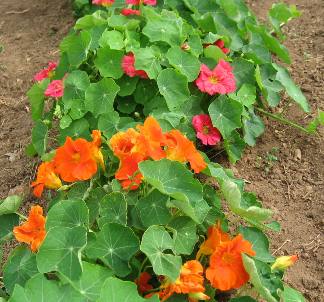Monthly Garden Gossip
March, 2012
Welcome to our garden! We're proud of our hard work and want to share the reward with you, so here is what's going on in the garden this month..Central Alabama
Looking for some interesting yard art? We have it. Some how we just loved these Zen Frogs. Don't you think everyone needs one of these in their garden! We also fell in love with the flamingos. They made us laugh. |
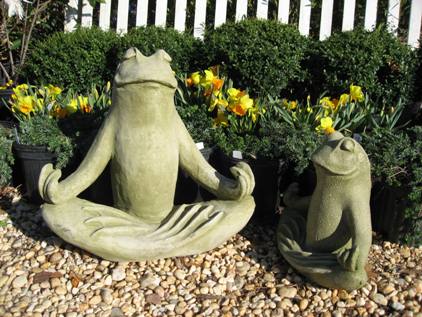 |
 |
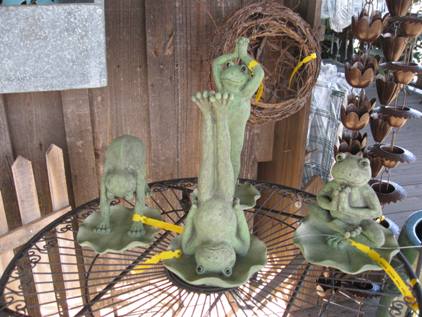 |
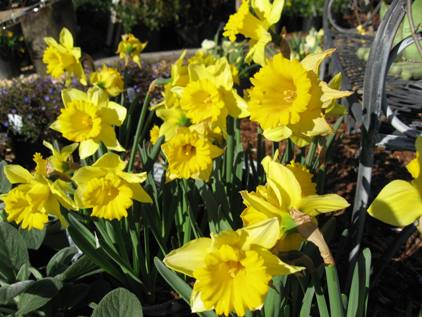 |
The daffodils are blooming right now. They certainly are the harbingers of spring around here. If you would llike to add to your collection, we have them blooming in containers just waiting for you to pop them into your border. Shelley has tried to buy the most reliable ones for the south. Some times it is hard to buy those brown bulbs in the fall but when you can see the flowers.........it is hard to resist them. We also have many other spring flowering bulbs ready to bloom. Daffodils are not the only early flowering plants, there is flowering quince, Edgeworthia, Japanese magnolia and Star magnolia and Hellebores just to name a few. I also love the blooms on the Sasafrass trees this time of year. Their lime green color looks great in any bouquet or flower arrangement. |
Late Winter Sprays Copper sprays are excellent for bacterial problems such as fire blight on apple and pear trees and bacterial spot on peach, nectarine, plum and cherry. It is generally best not to mix copper with other spray materials. Don't spray copper within 2 to 3 weeks of lime sulfur or oil sprays. If you ar having a problem with scale insects and eggs, mite eggs plus overwintering fungal and bacterial pests you could use Liquid Lime Sulfur Spray, Parafine Horticultural Oil, Year-Round Spray Oil, Hi-yield dormant Spray, Saf-t-side (80% petroleum oil or Fertilome dorman Spray and Summer Spray Oil, ( 98.8% horticultural Oil. Don ot apply oil sprays within 48 hours of a hard freeze, (below 30 degrees) because freeze damage may be increased.
|
Bloom Sprays
Bloom sprays are used late February through early April. From first bloom until essentially all flowers have opened. One or two sprays are adequate. We use bloom sprays to control fungal and bacterial diseases.The sprays be be applied throughout bloom. When applying copper be careful to use the recommended rates to aviod bloom damage and apply during pink bud- early bloom period. Bloom sprays for fungal problems such as brown rot mat not be needed every year but are suggested if brown rot on fruit was severe the previous year. Suggested products are Hi-yield Captan, Hi Yield Vegetable, Flower, Fruit and Ornamental Fungicide (12.5% chlorothalonil )and Fruit Tree Vegetable , Ornamental Fungicide (29.6% chlorothalonil) You may also use Liquid Copper Fungicide and Liquid-Cop. Do not spray insecticides during bloom period to protect pollinating bees. |
Cover Sprays This spray begins at petal fall (nearly all flower petals have fallen.) and runs until 15 days before harvest. These sprays are used mainly to control insect and disease problems of the fruit. (especially plum curcullio which causes wormy fruit and brown rot which causes fruit rots). The first 2 to 3 sprays should be 7 to 10 days apart with later sprays up until near harvest 2 to 3 weeks apart. Suggested products are Hi Yield Captain Fungicide, Dusting/Wettable sulfur, Thiomyl. When using Thiomyl include Captain in the spray to reduce possible development of resistant strains of brown rot. For plum curculio and other insects, Mal-A Cide (50% malathion) Monterey Garden Insect Sray (0.5% spinosad) The old fruit tree spray that contained Malathion and Captan is no longer available. However the gardener can prepare the sme spray by mixing per directions the captan and malathion together. |
Fire Blight
Fire blight is the enemy of apple and pear trees. It is caused by a bacteria that attacks the blossoms and moves up to the twigs and then the branches turning the blossoms brown and shriveling and blackening the twigs and branches. In advanced cases discolored oozing patches form on the branches. Fire Blight is easily spread by rain splashes, birds and insects. Gardeneres can also spread the disease on infected gardening tools. Disinfect your tools with a 10% clorox solution when trimming infected trees. Dispose of infected plant material by burning or discarding in the trash. Copper sprays are excellent or bacterial problems such as fire blight. Fire blight spray which contains streptomycin may be used also. Spreptomycin should be sprayed about every 10 days during bloom to be effective. |
| You man also spray your roses with lime sulphur. It really does help them with disease and overwintering insects. You may prune your roses back by 1/3 now into a dome shape. Prune only the repeat flowering roses right now. When you are through fertilize all of them with a good rose fertilizer. I am particularly fond of the fertizler that has the systemic insecticide in it. It kills all the aphids that are just waiting to suck the life out of your new growth. I also use it on my daylilies since aphids are always hiding down in the leaves and are hard to get to with spray.When your spring blooming roses are finished flowering you may prune them back. |
| Start seeds for your vegetable garden now. Start tomatoes and lettuce. You can also plant another crop of cabbage, broccoli, and carrots. Don't forget to plant a few potatoes this year. They are wonderful when you dig them fresh from the garden and take them to the kitchen. We have a few tomato plants ready right now but the bulk of them will be ready about the middle of March. This year we have 50 different varieties of tomatoes to choose from. The lettuce plants are ready right now just in case you don't want to fool with the seed. Tuck in a few nasturtiums, they are one of the edible flowers. They really add lots of color to your salads and are quite delicious |
Nasturtiums |
Prune evergreens, pine, hemlock, yew, cleyera and cedar now before they start to grow. Prune spring blooming shrubs after they flower. Don't wait too long or your will remove next years buds. Prune boxwoods if needed. Open up the inside to allow air circulation and light. Prune pomegranate and summer flowering shrubs. Lilac Chaste tree, Anthony Waterer Spirea and Pee Gee hydrangea should also be pruned now while dormant. Hydrangea arborescens, Annabelle hydrangeas, can be pruned to the ground since they flower on new growth. If the stems are cut to the ground the new shoots produce larger inflorescences. Don't prune your hydrangea macrophylla, mopheads and lacecaps until after they leaf out. Then prune only the branches that are dead. For pink blooms on the hydrangeas use lime; for blue blooms use aluminum sulphate or camellia and azalea fertilizer. |
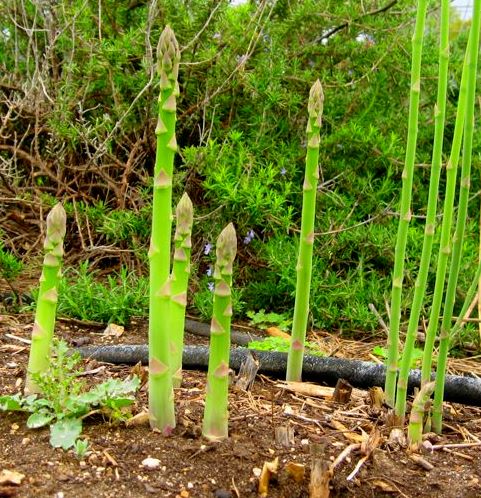 |
Consider starting an asparagus bed this year. It is a long lived perennial up to 15 years. Plant it in a sunny corner of your garden where you will not have to disturb it. Asparagus likes lots of organic matter to develop a good root system. To prepare your bed loosen the soil to a depth of 8 to 10 inches and then add about 3-4 inches of compost and about 1/2 pound of garden fertilizer per 20 ft row. When it is time to plant dig a trench about 8 inches deep and about 12 inches wide. Space crowns about 15-18 inches apart. Form a small mound of soil for each crown that you are going to plant. Place a crown on each mound spreading out the roots. Cover the crown with 2-3 inches of soil or compost and water well. Over the next few weeks add more soil until the trench is full. You cannot harvest the first season but should let the plant develop a good root system. By the second year it would be okay to pick just a few. The third season you may harvest for 4 to 6 weeks. Keep the weeds out and mulch the plants before the heat of the summer arrives. Fertilize the asparagus twice a year. I fertilize in February and then once when I finish harvesting.. Let the ferny foliage grow during the summer until it turns brown after the first freeze. Then cut it down. It is also a good idea to add more compost to your bed after you have cut all the brown foliage away. I also remulch the bed to keep down the winter weeds. |
| Prune muscadines now. Fertilize all your pecan trees with a pecan fertilizer that has zinc. Fertilize blackberries, blueberries and all fruit trees. We use a 12-6-6 fertilizer on the blueberries and blackberries and a Citrus, Pecan and Fruit tree fertilizer on the fruit trees. This fertilizer contains all the micro-nutrients the trees need for good fruit production. |
